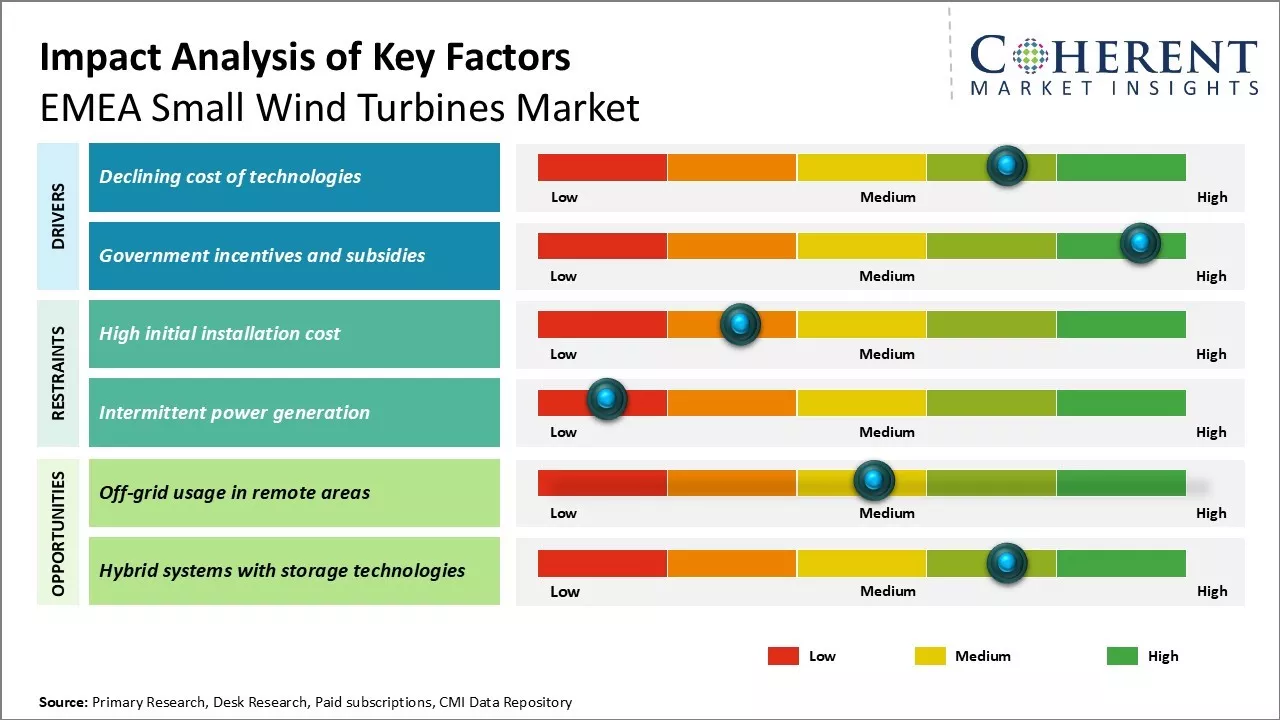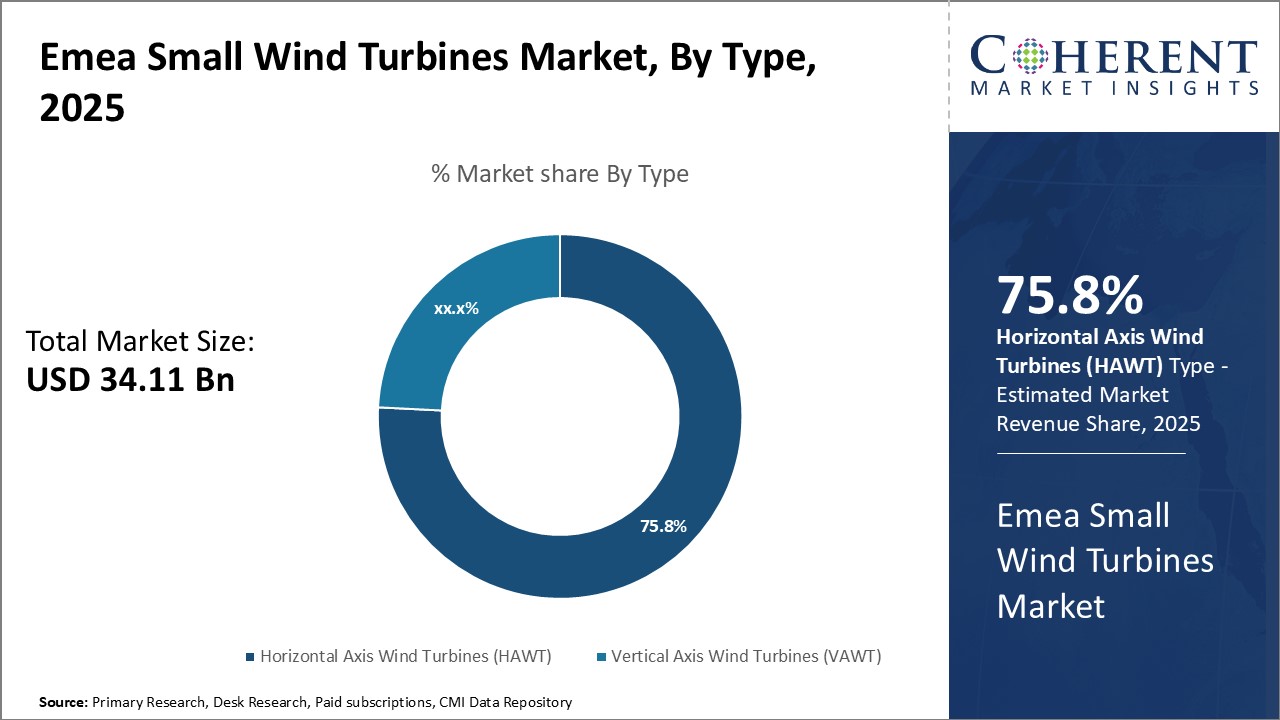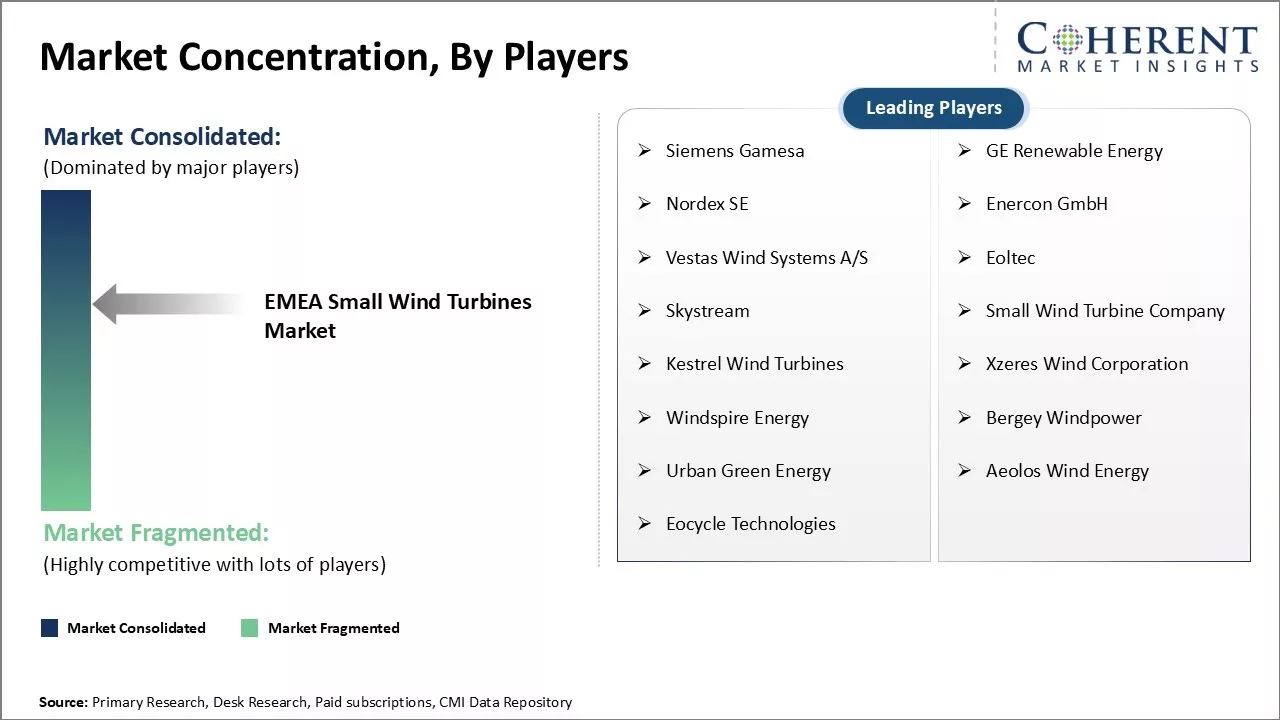EMEA small wind turbines market is estimated to be valued at USD 34.11 Bn in 2025 and is expected to reach USD 52.66 Bn by 2032, exhibiting a compound annual growth rate (CAGR) of 6.4% from 2025 to 2032.

Discover market dynamics shaping the industry: Download Free Sample
EMEA small wind turbines market is expected to witness steady growth on account of support through various government initiatives and schemes promoting the adoption of renewable energy in the region. Countries across Europe, the Middle East, and Africa are formulating net zero emission targets which is increasing the focus on developing diverse clean energy solutions including small wind power to transition away from fossil fuel-based power generation.

Discover high revenue pocket segments and roadmap to it: Download Free Sample
Insights by Type: Reliability and efficiency drive HAWT adoption
In terms of type, horizontal axis wind turbines (HAWT) segment is estimated to hold the highest share of the market of 75.8% in 2025, owing to their well-established reliability and efficiency. HAWTs have been in use much longer than vertical axis wind turbine (VAWT) and their horizontal design allows them to efficiently capture wind from all directions. With two or three blades rotating around a horizontal axis parallel to the ground, HAWTs can generate electricity even during fluctuating wind conditions. Their simplicity of design also makes them less prone to maintenance issues compared to complex VAWT designs.
Insights by Capacity: Accessibility drives uptake of sub 10kW turbines
In terms of capacity, up to 10 kW segment is estimated to hold the highest share of the market of 40% in 2025, owing to its accessibility for small home/farm installations. Turbines in this lowest rating are designed for ease of setup and use without heavy civil works or electrical expertise. Weighing only around 150 kg, a 5-10 kW turbine can typically be installed on a standard residential pole or free-standing tower under 10m high via basic mounting hardware.
Insights by Application: Energy security and cost savings drive residential uptake
In terms of application, residential segment is estimated to hold the highest share of the market of 38.1% in 2025, due to benefits of energy security and savings. Rising electricity rates, climate concerns and incentives are driving many households to self-generate a portion of power needs through small wind installations. Even partial reliance on a turbine can significantly offset consumption from the grid over its 20+ year lifespan. Rather than depending on utility price hikes, homeowners gain autonomy over energy costs by harvesting free wind sources on their properties. It also reduces long-term carbon footprints aligning with environmental values.

Get actionable strategies to beat competition: Download Free Sample
Top Strategies Followed by EMEA Small Wind Turbines Market Players
Established Players: R&D Investment
Leading companies in the EMEA small wind turbines market focus heavily on research and development to drive innovation. Industry giants like Vestas and Siemens Gamesa invest over 5% of their annual revenue into R&D. This allows them to constantly develop more advanced technologies that improve machine performance and efficiency.
Mid-Level Players: Cost-Effective Solutions
Medium-sized players in the market stay ahead by offering affordable products. Companies like WinWinD and Bergey Windpower target price-sensitive prosumers and communities with competitively priced turbines that provide excellent value.
Small-Scale Players: Niche Specialization
Numerous boutique firms have entered the industry by addressing specialized niche needs. For example, companies like Kingspan Environmental and Ampair focus solely on developing unique vertical axis designs optimized for difficult terrains or rooftop installations.
Emerging Startups in the EMEA Small Wind Turbines Market
Innovative Technologies
Several startups are bringing transformative technologies to the market. Universal Wind for instance uses smart sensors and AI to optimize turbine performance according to real-time conditions. Meanwhile, companies like Windspeaker and KAirro develop drones equipped with turbines that can harness wind energy at different altitudes for extended duration.
Sustainable Solutions
Environmentally conscious startups offer renewable alternatives. Dutch company Ventic catches the attention of investors with its bio-composite blades that degrade harmlessly at end-of-life. Belgium's Anthropic manufactures turbines using recycled plastic waste and 3D printing techniques. Their innovative processes help reduce material consumption.
Market Contribution: Niche Markets
Startups play a vital role by addressing specific customer and location types ignored by larger players. London-based Urban Green Energy has success with miniature turbines tailor-made for installation on residential rooftops and balconies in urban conglomerations.
Key Takeaways from Analyst
EMEA Small Wind Turbines Market Report Coverage
| Report Coverage | Details | ||
|---|---|---|---|
| Base Year: | 2024 | Market Size in 2025: | US$ 34.11 Bn |
| Historical Data for: | 2020 To 2024 | Forecast Period: | 2025 To 2032 |
| Forecast Period 2025 to 2032 CAGR: | 6.4% | 2032 Value Projection: | US$ 52.66 Bn |
| Segments covered: |
|
||
| Companies covered: |
Siemens Gamesa, GE Renewable Energy, Nordex SE, Enercon GmbH, Vestas Wind Systems A/S, Eoltec, Skystream, Small Wind Turbine Company, Kestrel Wind Turbines, Xzeres Wind Corporation, Windspire Energy, Bergey Windpower, Urban Green Energy, Aeolos Wind Energy, and Eocycle Technologies |
||
| Growth Drivers: |
|
||
| Restraints & Challenges: |
|
||
Uncover macros and micros vetted on 75+ parameters: Get instant access to report
Market Driver - Increasing emphasis on renewable energy
EMEA small wind turbines market is expected to witness steady growth over the coming years. The rising demand for sustainable energy sources will be a key driver for the market. More countries and municipalities in the region are promoting the adoption of renewable energy which benefits the market. In November 2023 According to the Climate Action Tracker, South Africa has pledged to phase out coal and increase renewable energy capacity to over 20,000 MW by 2030
Market Challenge - High initial installation cost
The high initial installation cost of small wind turbines is significantly hampering the growth of the EMEA Small Wind Turbines Market. Setting up a small wind turbine involves major capital expenditure since it requires high quality components and machinery that are costly. The turbine blades, gearboxes, generators and support towers are some of the expensive parts that contribute to the high initial investment. As per data analysis done by the European Renewable Energy Federation in 2021, installation and civil works contribute to around 30-35% of the total capital outlay required for small wind projects.
Market Opportunity- Application for Off-Grid Energy Needs in Remote Areas
One of the major opportunities for the EMEA small wind turbines market is their application for off-grid energy needs in remote areas. Several regions within Europe, Middle East and Africa lack access to centralized power grids given the difficult terrains and widespread geographical presence. For example, according to Ministry of Energy Kingdom of Morocco, over 250 small wind-solar hybrid systems have been installed since 2020 in villages located in remote inland regions of Morocco.
Share
Share
About Author
Sakshi Suryawanshi is a Research Consultant with 6 years of extensive experience in market research and consulting. She is proficient in market estimation, competitive analysis, and patent analysis. Sakshi excels in identifying market trends and evaluating competitive landscapes to provide actionable insights that drive strategic decision-making. Her expertise helps businesses navigate complex market dynamics and achieve their objectives effectively.
Missing comfort of reading report in your local language? Find your preferred language :
Transform your Strategy with Exclusive Trending Reports :
Frequently Asked Questions
Joining thousands of companies around the world committed to making the Excellent Business Solutions.
View All Our Clients